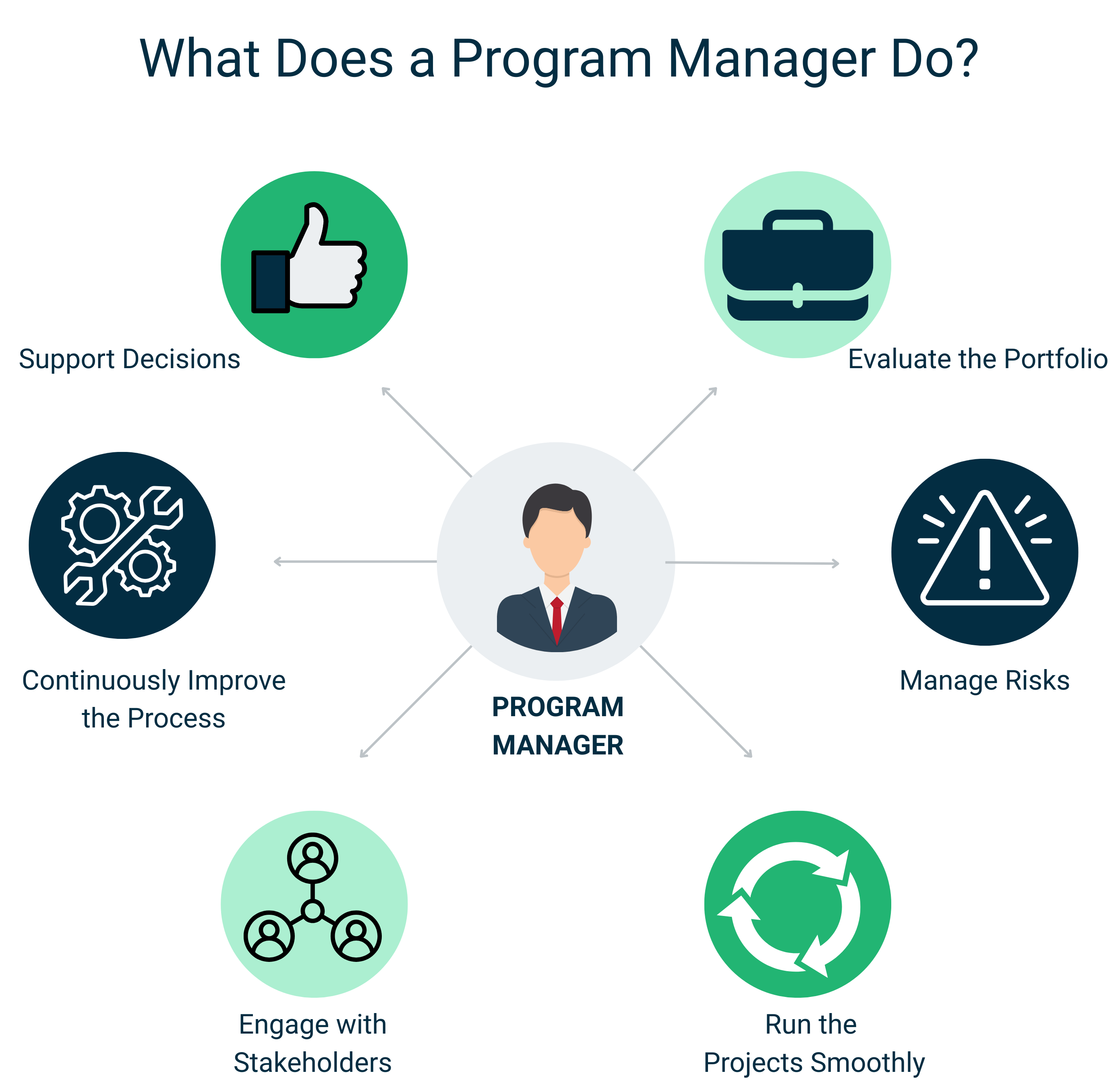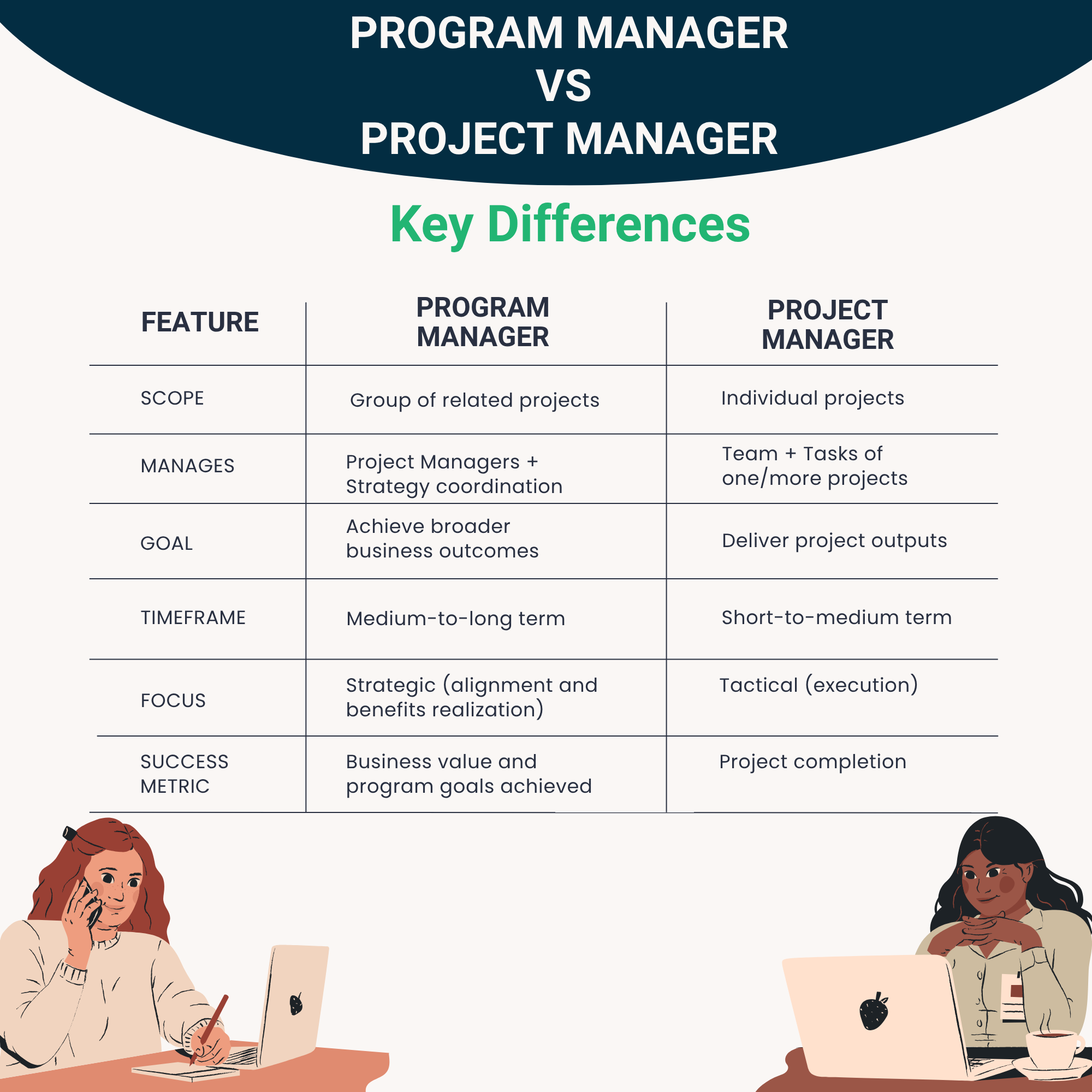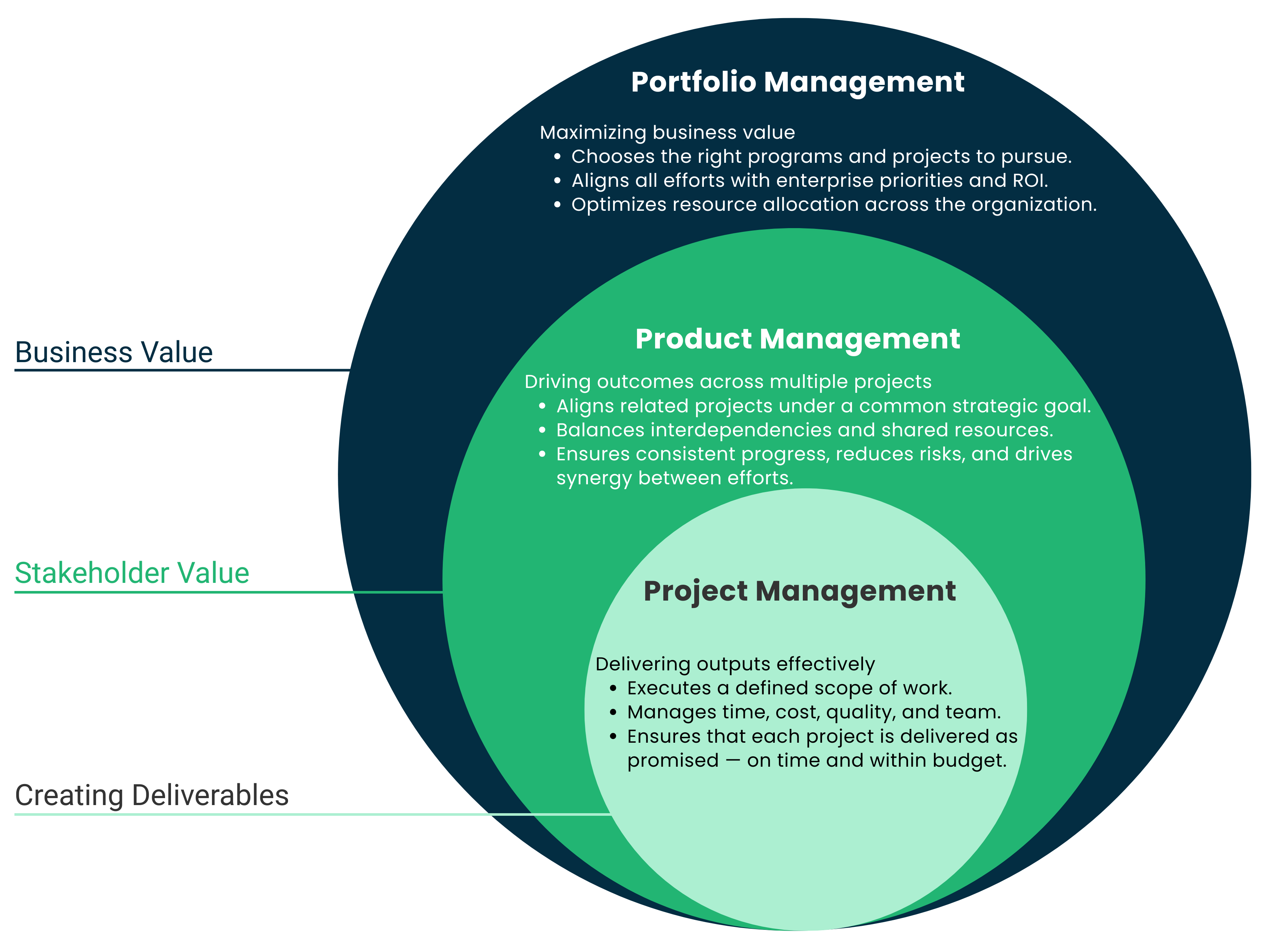
Quick Summary: Struggling to align strategy with execution? This article breaks down program vs project management—and how predictive intelligence bridges the gap to prevent delays, budget overruns, and misaligned goals. Learn how TrueProject delivers real-time foresight, risk alerts, and smarter execution to connect every task to strategic impact.
In 2025, managing complex organizational goals has become increasingly challenging. According to Wellingtone (2024), 47% of organizations struggle to access real-time KPIs, leading to misaligned efforts between program and project management. As businesses strive to deliver strategic outcomes while executing tactical tasks, the distinction between these two disciplines often blurs—creating inefficiencies that can derail success.
At a glance, program management oversees multiple interconnected initiatives aligned with broader goals, while project management focuses on specific outcomes within defined constraints. Yet, despite their differences, both share a core mission: driving value for the organization. The challenge lies not in their structure but in their coordination—ensuring efforts flow seamlessly without wasting resources or missing opportunities.
In this article, we unpack the nuances of program management vs project management, demystify the unique roles they play, and introduce predictive intelligence—an AI-powered, data-driven approach that bridges the operational divide. You’ll discover how real-time analytics, forecasting, and smarter decision-making can align teams and elevate execution across the board.

Key Differences: Program Management vs Project Management
Understanding the distinction between program and project management is foundational to optimizing organizational performance and workflows. Though interdependent, these disciplines operate at different levels, often creating confusion among teams, executives, and even clients.
Program management involves the coordinated oversight of multiple related projects that drive broader, strategic outcomes. Think of it as the “orchestra conductor” ensuring every section plays in harmony. For example, launching a new product line may encompass several projects: market research, product design, manufacturing, and go-to-market strategies. According to Straits Research (2023), 57% of organizations use a centralized Program Management Office (PMO), highlighting its critical role in long-term value realization and alignment with business objectives.
Project management, in contrast, is laser-focused on tactical execution—delivering a defined outcome within fixed parameters of time, budget, and scope. Whether it’s developing a mobile feature or rolling out a training program, a project has a clear start and end point. However, the path is rarely smooth: Wellingtone (2024) reports that only 34% of organizations complete projects on budget, underscoring how complex execution can become even with clear goals.
This clear delineation highlights why alignment matters. Without a shared understanding of their scope and interdependencies, organizations risk duplicated efforts, resource conflicts, and broken communication loops—which ultimately impact both strategic momentum and day-to-day execution.
Let’s now explore the real-world challenges that arise when program and project management operate in silos, and how these disconnects cost organizations time, talent, and significant budget.
Seeing these gaps in your own delivery pipeline? Schedule a discussion to see how predictive insights can spot misalignment before it becomes a million-dollar mistake.
 Challenges in Program Management vs Project Management
Challenges in Program Management vs Project Management
Despite aiming for a common outcome—organizational success—program and project management often run into friction due to their inherently different approaches. The ripple effects of these gaps can be substantial.
Ineffective communication is a major challenge in project management. According to a PMI study, ineffective communications is the primary contributor to project failure one third of the time, and puts $75 million at risk for every $1 billion spent on a project1. This issue manifests at both strategic and executional levels, often resulting in cascading breakdowns that scale quickly and jeopardize project outcomes.
Program managers face the challenge of aligning multiple projects to strategic goals while managing cross-functional dependencies. For example, a delay in a product testing project can disrupt a tightly timed marketing campaign, impacting time-to-market and revenue forecasts. Resource conflicts—where teams are stretched across competing initiatives—are another critical pain point. At the Project Level:
Project managers juggle with granular execution challenges—budget overruns, scope creep, timeline delays. Without real-time visibility into shifting constraints, managers often make reactive decisions. Wellingtone (2024) emphasizes this gap, noting that only 34% of projects meet budget targets, and many derail due to insufficient foresight or outdated reporting.
What becomes clear is that program managers lack detailed visibility into project-level threats, while project managers often lack clarity on the strategic ‘why’ behind their work. This misalignment isn’t just an efficiency issue—it erodes stakeholder trust, inflates costs, and diminishes impact.
To solve this, organizations need more than process improvement—they need a smart, connected layer of intelligence that brings foresight, alignment, and agility. Enter: predictive intelligence.
Still unclear on how strategy and execution diverge in your organization? Watch our 2-minute explainer to see TrueProject in action—through the lens of predictive intelligence.
 The Role of Predictive Intelligence in Bridging the Gap
The Role of Predictive Intelligence in Bridging the Gap
So, how do we bridge the divide between strategy and execution in a way that’s agile, data-informed, and future-ready?
Predictive intelligence is the answer.
At its core, predictive intelligence uses real-time data, machine learning models, and contextual signals to forecast what’s likely to happen—then guides action before risks escalate. Unlike traditional reporting, which tells you what happened after the fact, predictive systems offer a forward-looking lens that both program and project managers can rely on.
Think of it as a strategic compass and operational radar rolled into one. For program managers, predictive insights help anticipate portfolio risks, resource bottlenecks, or misaligned priorities. For project managers, it can flag task delays, capacity overloads, or budget drift—weeks before they snowball.
A McKinsey study found that predictive analytics improved resource utilization by 20%, enabling project managers to balance workloads and reduce burnout among team members.
In short, predictive intelligence empowers teams to move from reactive firefighting to proactive planning, creating a common language between strategic vision and tactical execution.

Practical Applications: Use Cases of Predictive Intelligence
To understand the real-world impact, let’s look at how predictive intelligence reshapes both program and project environments:
- Proactive Risk Identification
Predictive tools can monitor thousands of data points across programs and projects, surfacing hidden risks before they become visible. For instance, if multiple projects show signs of resource strain, the system can flag this to the program manager—prompting realignment before schedules derail. - Smart Resource Allocation
Instead of allocating resources based on manual estimates or gut feel, predictive systems analyze workload trends, past velocity, and project criticality to recommend optimal distribution—boosting productivity without burnout. - Strategic Goal Alignment
With predictive insights, project teams can see how their work ladders up to broader strategic goals. This transparency builds clarity and purpose, helping teams prioritize efforts that truly move the needle. - Forecasting Success Rates
By analyzing historical and current project data, AI models can estimate the likelihood of on-time and on-budget delivery. This visibility helps leaders course-correct early—whether that means adjusting scope, reallocating teams, or resetting expectations.
These applications aren’t theoretical—they’re already being implemented across industries from tech and finance to healthcare and government. And the results are consistent: better coordination, faster execution, and higher stakeholder confidence.
Curious how this works in real enterprise environments? See real use cases brought to life in our interactive product demo—tailored for program and project leaders.

Implementing Predictive Intelligence: Where to Start
Integrating predictive intelligence into your program and project ecosystem doesn't require a full overhaul—but it does require intentional steps:
1. Audit Current Workflows
Start by identifying gaps in visibility, data collection, and cross-team communication. Where are decisions made based on lagging data? Where do silos exist?
2. Invest in the Right Tools
Choose platforms that offer integrated predictive analytics across both strategic and executional layers. Look for solutions with customizable dashboards, early warning systems, and strong integration capabilities (e.g., with Jira, MS Project, or ERP systems).
3. Establish a Single Source of Truth
Centralize data streams into one platform to enable consistent insights. Predictive intelligence thrives on data richness—so unify inputs across teams, projects, and functions.
4. Train Teams to Interpret Signals
It’s not just about having the data—it’s about knowing what to do with it. Train project and program managers to understand risk forecasts, trend indicators, and impact predictions—and embed those insights into decision-making rituals.
5. Lead with Change Management & Executive Sponsorship
Adoption of predictive intelligence isn’t purely technical—it’s cultural. Executive sponsorship is critical not just for funding, but for role modeling data-driven decision-making. Appoint change champions across business units who can evangelize use cases, address resistance, and ensure predictive insights are embedded in operational rhythms—not sidelined as “extra data.”
Gartner (2024) reports that only 48% of digital transformation initiatives meet or exceed business outcome targets. Make change leadership part of the implementation roadmap from Day 1. By starting small and scaling intelligently, companies can turn predictive intelligence from a buzzword into a competitive advantage.
Ready to move faster with more clarity? Get started with TrueProject’s QuickStart—designed to deliver visible results in weeks, not quarters.
Conclusion: Aligning Strategy with Execution in 2025 and Beyond
The divide between program management vs project management isn’t a flaw—it’s a feature of how modern organizations scale. Program management sets the direction; project management builds the road. But when they move in isolation, the cost is high: misalignment, delays, scope creep, and an alarming $122 million wasted for every $1 billion invested (project.co, 2024).
Predictive intelligence isn’t just a tech solution—it’s a mindset shift. It empowers leaders to spot risks early, align decisions with real-time data, and drive outcomes that reflect both vision and execution.
With advanced project management solutions like TrueProject, organizations can implement predictive intelligence quickly, driving visibility, early intervention, and elevating project ROI phenomenally. TrueProject makes the invisible visible—connecting every project detail back to strategic goals. It’s the foresight engine today’s leaders didn’t know they needed.
Built to integrate effortlessly and act decisively, it gives decision-makers exactly what they need: clarity, control, and confidence. If aligning outcomes with strategy is non-negotiable, then TrueProject is imperative.
Want to explore what this means for your org? Let’s talk. Schedule a discussion session with our specialists to map predictive intelligence to your current project workflows.
FAQ
- What is the difference between program management and project management?
Program management focuses on long-term strategic alignment across multiple related projects. Project management executes specific tasks with defined timelines, budgets, and deliverables. - How does predictive intelligence help in project and program management?
It forecasts potential risks, resource gaps, or delivery delays by analyzing real-time and historical data—enabling faster, smarter decisions at both strategic and execution levels. - Which is better: program management or project management?
Neither is better—they serve different purposes. Program management focuses on long-term strategic goals across multiple projects, while project management ensures individual projects are executed efficiently. The best choice depends on your organization’s needs. - Can one person handle both program and project management?
It’s possible, but not ideal for complex initiatives. Handling both roles requires balancing high-level strategy with day-to-day execution, which can lead to oversight or burnout. Separate roles ensure better focus and accountability.






